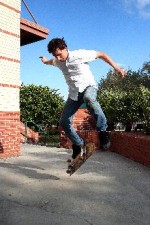Ripping it up

Empty of cars, the vacant concrete slopes of the Leroy Collins parking garage are perfect for longboarders who want a rush of speed. The flat, smooth surfaces on each floor are ideal practice grounds for skateboarders who want to perfect their ollies and kickflips.
On any given night, you are likely to hear the rush of air and quick click of wheels over pavement as the structure turns into a makeshift on-campus skatepark.
It is unclear how the first skateboard came to be, according to Skateboardhistorian.com. Some claim it started as a scooter, which was then modified, and |others claim surfers simply created a way to surf without waves. The first commercial skateboard went on sale in 1959, and by the ’60s skateboarding had quite the surfer following.
Thanks to Frank Nalsworthy’s development of the urethane wheel, skateboarding regained popularity in the ’70s with a vengeance.
The first skatepark opened in 1976 in Port Orange, Fla. In the same year, the California Z-Boys (think Lords of Dogtown) birthed the vertical skating trend by riding empty pools. Of the group, Tony Alva and Stacey Peralta started two of the first skateboarding companies, Alva Skates and Powell-Peralta, respectively.
Insurance liabilities forced most skateparks to shut down in the early ’80s, causing a popularity slump for skateboarding. By the X-Games in the mid-’90s, however, it was back in the limelight.
USF students who walk to class quickly learn to listen for the telltale staccato of a skater approaching from behind.
Those who skate to class generally become deft at maneuvering their way through thick crowds of pedestrians.
Junior Tonia Ackley tried skating to classes, but claims that the sea of people who refused to move made the going difficult. She first learned to skateboard in high school on her sister’s board, but didn’t get heavily into the activity until her freshman year at USF when she bought her first longboard.
“I’m coming at you going six miles an hour. Move!” Ackley said.
Fellow skater Nick Holm, a sophomore, began skating when he came to USF – his preference is also a longboard because it’s easier to coast than a skateboard.
“I wanted a way to get around campus,” he said. “It’s fun and it’s easier to carry than a bike.”
Seasoned skater and junior Chris Bemelmans has been skateboarding for seven years. He skates daily between classes and during schedule gaps, though he prefers a skateboard to a longboard.
“There’s more stuff you can do on it,” he said. “You’re more limited on a longboard. You can always learn something new on a skateboard.”
Just as each skater has a history, every skateboard has a story. The artwork is often an expression of a skater’s personality.
Bemelmans’ skateboard is torn up from use, and one can barely tell what was there before grinds erased the picture. Bemelmans explained that it was Corporate Pig – a pig with a dagger and a money symbol on its forehead – that represents capitalism and money as the root of all evil. He always rides a Zero deck, but said he picks whatever artwork he’s feeling at the time.
Despite its fluctuation in popularity, skateboarding is continually a catalyst for camaraderie.
Junior Cat Hohmann said she’s made a lot of friends through their common interest. “We’ll meet at a party and say ‘hey, let’s go skating,'” she said.
Upon meeting, different skaters typically know nothing about each other except that both enjoy the pastime. That’s all they need to know. Within minutes, one skateboarder is giving advice to another on how to nail an ollie and they’re laughing like old friends, according to Hohmann, who has met people on campus through skateboarding.
If you’re new to college and a little bit shy, skateboarding can be a great way to meet people. It’s bound to jumpstart a conversation, and it’ll get you from point A to point B a lot quicker than walking.






